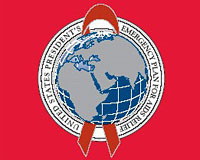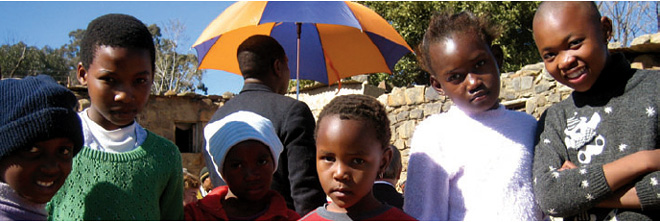| Pediatric Treatment and Care (Updated December 2007)  PDF version PDF version
 |
President George W. Bush's
Emergency Plan for AIDS
Relief is the largest commitment
ever by any nation for an
international health
initiative dedicated to
a single disease-- a
five-year, $15 billion,
comprehensive approach to
combating the disease
around the world.
U.S. Department of
State
U.S. Agency for
International
Development
U.S. Department of
Defense
U.S. Department of
Commerce
U.S. Department of
Labor
U.S. Department of
Health and Human
Services
Peace Corps
Mailing address:
SA-29, 2nd Floor
2201 C Street, NW
Washington, DC 20522-2920
www.PEPFAR.gov
| |

Pediatric Treatment and Care
Children and infants represent almost 15 percent of all new HIV infections worldwide. Despite the large number of children living with HIV/AIDS, children currently have disproportionately low access to HIV treatment and care relative to adult populations in most developing countries. Without treatment and care, approximately 50 percent of all HIV-positive children will die before age two. In addition to preventing transmission from mother to child, the U.S. President’s Emergency Plan for AIDS Relief (Emergency Plan/PEPFAR) is working with host nations to provide family-centered treatment and care services for children living with and affected by HIV/AIDS.
Barriers currently limiting the scale-up of pediatric treatment and care services include a lack of providers equipped with the necessary skills to address the special needs of HIV-positive children, the relatively high cost of pediatric antiretroviral treatment formulations, regulatory barriers to registering pediatric formulations, and limited information about pediatric doses of medicines at different ages and weights. In March 2006, First Lady Laura Bush announced the Public-Private Partnership for Pediatric AIDS Treatment, through which the U.S. Government is now working with pharmaceutical companies, implementing organizations, and multinational organizations such as the United Nations Children’s Fund (UNICEF) and the World Health Organization (WHO) to address these barriers.
|
The Power of Partnerships:
- Through September 30, 2007, of the people receiving antiretroviral treatment through direct U.S. Government (USG) support in the focus countries, nearly 86,000 are children age 14 and under; a 77 percent increase over the number of children on PEPFAR-supported treatment in 2006.
|
In order to rapidly increase the number of HIV-positive children receiving life-saving antiretroviral treatment and care, PEPFAR is linking prevention of mother-to-child transmission (PMTCT) programs with pediatric follow-up, including pediatric treatment, pediatric training for providers, routine testing of children, and laboratory capacity building and systems-strengthening for early infant diagnosis. In some PEPFAR countries, HIV diagnosis in babies can now be done as early as six weeks after birth by collecting dried blood samples.
A new focus will be on routine testing of sick children in pediatric medical settings, which is expected to rapidly identify large numbers of HIV-positive children, and provide the possibility of direct links to treatment and care. |
|

|
PEPFAR-supported interventions to optimize survival of HIV-exposed and infected children:
- Provision of basic preventive care, including support for infant and young child nutrition, and prevention of infections such as malaria, tuberculosis and pneumonia;
- Links and referrals to routine child health services;
- Clinical staging and regular monitoring to determine eligibility for antiretroviral treatment;
- Antiretroviral treatment for children provided in a family-centered context;
- Treatment of malnutrition and life-threatening infections, such as diarrhea and pneumonia;
- Pain and symptom management; and
- Support for children and their families, including psychosocial support and support for orphans and vulnerable children.
|
The Emergency Plan at Work:
The following examples illustrate how the Emergency Plan is working under national strategies and in partnership with host nations to support pediatric treatment and care programs:
- In Botswana, a pediatric center of excellence is treating over 1,200 children using a family-centered model of care. Clinical outcomes in this center have been excellent, with an overall mortality of less than one percent among children on antiretroviral treatment.
- Rwanda, Kenya, Botswana and Namibia and other countries are actively building laboratory capacity and expanding early infant diagnosis to facilitate pediatric HIV treatment and assess the impact of national PMTCT programs.
- In Nigeria, the Massey Street Children’s Hospital in Lagos has more than 700 HIV-positive children registered, of whom 207 are receiving antiretroviral treatment as of October 2006. The children serve as an entry point to treatment for other family members. All children receiving inpatient care, as well as their caregivers, are offered routine HIV counseling and testing, resulting in a high uptake among family members.
- In Thailand, networks of care providers and communities are helping HIV-positive children lead normal lives. Through June 2006, over 90 health providers from 16 hospitals attended HIV care and adherence counseling training, and over 300 children began antiretroviral treatment. Most patients have an adherence rate of more than 95 percent, which is higher than in most developed countries. The expanded expertise means treatment occurs closer to home, giving children stronger community support as they cope with the many challenges of being HIV-positive.
|
|
Resources:
- World Health Organization 2006 Treatment Guidelines for children can be found at www.who.int/hiv/pub/guidelines/en.
- The Handbook on Pediatric AIDS in Africa by the African Network for the Care of Children Affected by AIDS and other useful resources related to pediatric HIV are available online at www.anecca.org.
- Pediatric Antiretroviral and Cotrimoxazole Dosing: Pediatric Dosing in Resource-Constrained Settings is a pocket guide to the use of antiretroviral drugs for children in resource-constrained settings. It is available at http://bayloraids.org/resources/.
|
|
| |  |  |




 PDF version
PDF version